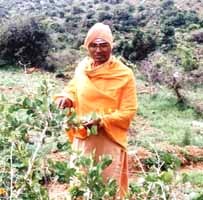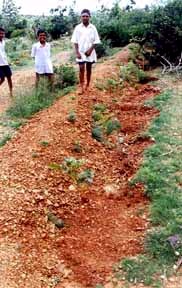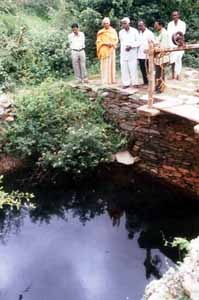Here we chant Jalaya namah (pray water) along with our regular prayer Shivaya namah. Water is our dharma," explains Shivakumara Swamiji, the seer of Nandiveri Math as he points out Bangara Halla, a stream nearby. "Bangara Halla should flow with all its beauty throughout the year. We are working hard for this." His words echo his confidence over the new mantra. 'Aap' (a kind of aqua plant) grown naturally in the rivulet writes prologue to the rejuvenation of Bangara Halla.

![]() Shivakumara Swamiji
Shivakumara Swamiji
Kapotagiri range spread over more than 70,000 acres in Shirahatti, Gadag and Mundaragi taluks of Gadag district in North Karnataka was known as Southern Shimla five decades ago, with thick forest, wild animals and valuable medicinal plants.
Not very late, modernisation hit the hill range, draining rich natural resources. Mining invaded beautiful vegetation with iron and manganese residues replacing the greenery. Trees were cut to meet the firewood demand. The highly productive hill became a barren land. Rare medicinal plants grown wildly in the hills started becoming endangered.
In the last one year Kapotagiri has witnessed a silent but intense effort to bring back its glory. The spirit behind this successful work being undertaken by the Forest Department is Nandiveri Math, situated at the base of Kapotagiri. They incorporated a two-point mission - soil and water conservation and afforestation. Simple and effective.
• Ponds transform drylands
The seer shared his views with the people of surrounding villages and their elected representatives and invited them to participate in the effort. Active involvement from the local forest officials helped early implementation of different related programmes. Various soil and water conservation activities were carried out in a 235 hectare area a portion of which belongs to the math. Forest Department took the project under its social forestry programme. District administration and Zilla Panchayat supported the effort through drought-relief programme.
Rejuvenation of Bangara Halla: A dream come true
Primary importance has been given to bring back the elegance to Bangara Halla with which it flowed four decades back. The aim is to make this 'monsoon stream' flow in all seasons. Various water harvesting structures have been constructed to stop and store rain water from hills which otherwise would run to the Dambala tank 12 kilometers away. Gully plugs check the water gushing towards the valley. A large percolation tank (Bangara kere) has been constructed at the starting point of Bangara Halla. Since the tank is situated at a greater height, water availability has increased in the downstream.

![]() 32 thousand trenches in the hill slope help in water percolation
32 thousand trenches in the hill slope help in water percolation
Boulder structures built across Bangara Halla stop running water and break its speed. Bamboo and blueberry seedlings planted in the tank's catchment area would work as natural check dams when they grow. Such structures have been created to all 13 waterways that join the stream. There are 2750 such checks. These structures which effectively store and percolate water have helped in rejuvenating Bangara Halla. Lively flora and fauna on both sides tell the comeback story of the stream.
To make the entire process more sustainable, afforestation has also been undertaken simultaneously. Initially about one and a half lakh seedlings of different species (neem, pongamia, tamarind, gooseberry, peeple, banian) have been planted in the area. Each plant is covered by a 'V' shaped trench which draws the surrounding water towards the plant. Water percolated into the pit and helps in the plant's survival.
To complement this, around 32 thousand trenches have been dug in the hill's slope. Each trench is 4 x 1.5 x 1.5 metres. In a single rain, approximately 1.5 crore litres of water percolates into the soil through these trenches. Neem and pongamia seeds that dibbled on the earth removed from the trench digging have started sprouting up. This will add 50 thousand more plants to the forest. The survival rate of plants which is above 90 percent is a rare phenomenon.
Ten bunds and eight check dams have also been constructed to block the running water. As the Range Forest Officer M.D. Kenchappanavar puts it, early and good monsoon has boosted up the entire work. Lush green atmosphere dancing to the tune of water supported his words. This young officer's enthusiasm and sincere effort in implementing the programme gets reflected in the work done. Every single work - from digging a trench to constructing a check dam - has been given proper attention yielding maximum result. 'Still there is a long way to go. The plants have just started growing up. They need suitable protection till they grow tall. So we are planning to do fencing to the entire area,' Kenchappanavar gives a glimpse of future tasks.
Green mantra brings greenery
Shivakumara Swamiji's green mantra is yielding results. This year Nandiveri Math's two dried up wells have sufficient water. But the seer is not content. He says, "This is not enough, we should be able to fetch water by hand!" He shows us the bore-well that spills water at one pull.

![]() Once dried up well has sufficient water
Once dried up well has sufficient water
As a result of all these efforts, water table in the nearby villages like Doni, Dambala, Mevundi, Kadampura has significantly been increased. This has raised confidence among farmers. Shivakumara Swamiji says, "If Bangara Halla starts flowing all through the year, it is a leap forward. Efforts are on. Let us hope for the best." He is planning to revive 50 tanks in the Kapotagiri range. On September 9, Nandiveri Math celebrated its jatra mahotsava (annual festival) as eco festival. Swamiji's words and deeds show his concern for water and nature.
Dust from the mining activities at the hillocks cover Kapotagiri posing serious challenge to the life-centered activities of the seer and other sincere souls. Swamiji says, "We are opposing mining in the hill range and wish that concerned people will put an end to this menace."
At a time when 'environment' has become a universal concern, efforts at Kapotagiri to restore its lost splendour through soil and water conservation is a model for the interested. It is also an inspiration for those who are searching for good models.
